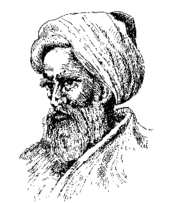De potentiis anime sensitive, Gregor Reisch (1504) Margarita philosophica. Medieval science postulated a ventricle of the brain as the location for our common sense,[22] where the forms from our sensory systems commingled.
Ibn al-Haytham (Alhazen), 965–1039 Basra, Buyid Emirate.
The Muslim scholar who is considered by some to be the father of modern
scientific methodology due to his emphasis on experimental data and
reproducibility of its results.[23][nb 6]
The House of Wisdom was established in Abbasid-era Baghdad, Iraq.[25] It is considered to have been a major intellectual center during the Islamic Golden Age, where Muslim scholars such as al-Kindi and Ibn Sahl in Baghdad and Ibn al-Haytham in Cairo flourished from the ninth to the thirteenth centuries until the Mongol sack of Baghdad. Ibn al-Haytham, known later to the West as Alhazen, furthered the Aristotelian viewpoint[26] by emphasizing experimental data.[nb 8][27]
In the later medieval period, as demand for translations grew (for example, from the Toledo School of Translators), western Europeans began collecting texts written not only in Latin, but also Latin translations from Greek, Arabic, and Hebrew. In particular, the texts of Aristotle, Ptolemy,[nb 9] and Euclid, preserved in the Houses of Wisdom, were sought amongst Catholic scholars. In Europe, the Latin translation of Alhazen's Book of Optics directly influenced Roger Bacon (13th century) in England, who argued for more experimental science as demonstrated by Alhazen. By the late Middle Ages, a synthesis of Catholicism and Aristotelianism known as Scholasticism was flourishing in western Europe, which had become a new geographic center of science, but all aspects of scholasticism were criticized in the 15th and 16th centuries.


No comments:
Post a Comment